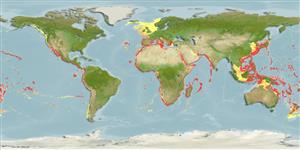Malacostraca |
Decapoda |
Pandalidae
Environment: milieu / climate zone / djupintervall / distribution range
Ekologi
; djupintervall 10 - 910 m (Ref. 434), usually 200 - 400 m (Ref. 434). Subtropical
Indo-Pacific, Atlantic Ocean and the Mediterranean: throughout the area including Madeira and Canary Islands, northward extending into the Mediterranean to the Azores, and southward extending to Angola.
Length at first maturity / Size / Weight / Age
Könsmognad: Lm 1.5 range ? - ? cm Max length : 14.5 cm TL hane/ej könsbestämd; (Ref. 434)
Maximum depth from Ref. 102668. Benthic adults inhabiting mud or muddy sand bottoms, often near rocky areas of the continental slope (Ref. 343). Also found in submarine caves (Ref. 102668). Occurs at depths of 10 to 900 m, common between 200 and 400 m. Pelagic juveniles (Ref. 343). Has a diversified diet. Mainly a predator of benthic species; may be an occasional scavenger (Ref. 102668).
Life cycle and mating behavior
Könsmognad | Reproduktion | Lek | Eggs | Fecundity | Larvae
Members of the order Decapoda are mostly gonochoric. Mating behavior: Precopulatory courtship ritual is common (through olfactory and tactile cues); usually indirect sperm transfer.
Fischer, W., G. Bianchi and W.B. Scott (eds.) 1981 Shrimps and prawns. 6: pag.var. In FAO species identification sheets for fishery purposes. Eastern Central Atlantic (Fishing Area 34, 47; in part). Canada Funds-in-Trust. Ottawa, Department of Fisheries and Oceans Canada, by arrangement with the Food and Agriculture organization of the United Nations. 1-7: pag.var. (Ref. 434)
IUCN Red List Status
(Ref. 130435: Version 2025-1)
CITES status (Ref. 108899)
Not Evaluated
Not Evaluated
Threat to humans
Human uses
Fiskeri: kommersiell
| FishSource | Sea Around Us
Verktyg
Ytterligare information
PhysiologySyreförbrukning
Human RelatedStamps, coins, misc.
Internet-källor
Estimates based on models
Preferred temperature
(Ref.
115969): 8 - 19.1, mean 13 (based on 604 cells).
Fishing Vulnerability
Low vulnerability (24 of 100).
